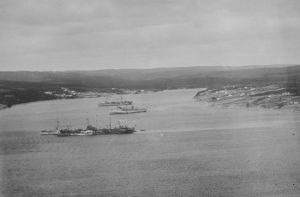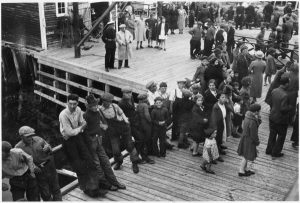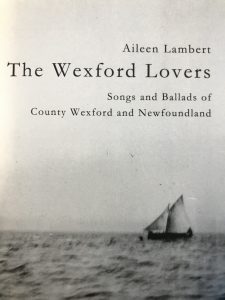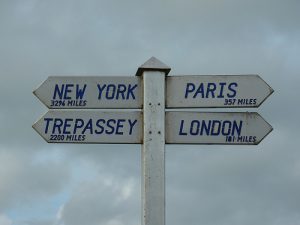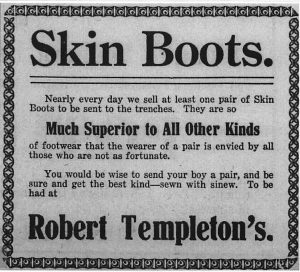In May 1919 an estimated 8500 American naval crew arrived in Trepassey Harbour and immediately commenced establishing a ‘naval base’ laying out a square and erecting tents to serve as ‘shore canteens’. The canteens would serve drinks, cigarettes tobacco and other ‘luxuries’.
The Naval vessels that had anchored in the harbour would eventually be stationed at about 50-mile (80 km) spacings as guides for American planes that were flying from Trepassey to Portugal via the Azores, thus completing the first successful (although not non-stop) transatlantic flight.
Looking about the town the Americans were quick to rent the largest building in the community the Temperance Hall which they quickly fitted for concerts. Their plan was to have the ships band give selections in the evenings bolstered with some excellent singers and good musicians that were among the crews.
 The St. John’s newspaper the Daily Star reported:
The St. John’s newspaper the Daily Star reported:
“Notwithstanding the change from fine to damp and somewhat foggy weather last afternoon, the men on shore leave enjoyed themselves well. They have one cause of complaint and that is the absence of places where they can spend their cash allowances in small wares and buy sweetmeats, chocolates and candies for their numerous friends of the village.”
Trepassey in 1919 had but one shop and its shelves were empty within hours of the arrival of the Americans.
The Daily Star reported:
“As Trepassey depends mainly on daily supplies of necessities from the city (St. John’s) no extensive business has been undertaken by any dealer here, hence the scarcity of such things that the Yankee sailor finds.”
 JOHN’S NEWSPAPERS SPAR OVER COVERAGE
JOHN’S NEWSPAPERS SPAR OVER COVERAGE
The St. John’s newspaper, the Evening Telegram was the first out of the gate to report on the armada of American Naval vessels in Trepassey Harbour but according to The St. John’s Daily Star the people of Trepassey were not amused at the coverage. The Star reported:
“The Evening Telegram report yesterday was puerile and greatly exaggerated nonsense. The few people that I (Daily Star) have shown these extracts are indignant and consider they have been held up to ridicule. The scene depicted of the “natives gathering “and discussing what made the flying machine go and how it was kept in the air “is untrue and a reflection of the good sense and intelligence of the people here and if the Evening Telegram writer had been present at the Trepassey railway station last evening when the men of this place heard it read from my message he would not stand long on the order of his getting away towards the city. He might have been raised a little in the air. Neither the Yankee sailors nor the people of Trepassey thank the Evening telegram writer for his efforts to misrepresent both and cast ridicule on the intelligent people of Trepassey”.
The Evening Telegram was quick to shoot back at the criticism from the Daily Star. Under the banner “News King at Trepassey” the Evening Telegram countered:
“The special reporter (Billie Murphy) of the Telegram who was in Trepassey for the purposes of obtaining firsthand information of the American activities in connection with their attempt at crossing the Atlantic stands by every word of his dispatch from Trepassey, despite the silly article contained in Yesterday’s Daily Star”.
The Evening Telegram took another critical shot at The Daily Star suggesting that their manner of collecting news was very suspect. The Star did not have a reported in Trepassey they were basing their reports on news from locals in the town. The Evening Telegram wrote:
“The public must not regard seriously a paper that receives a few dozen words and then adds and pads about ten times as much to it, the addition being pure conjecture and in one instance, at least, the frothy ebullitions of an intensely jealous Star scribe”.
TELEGRAM HAS TWO REPORTERS IN TREPASSEY: YANK SAILOR WRITES. MR. J. R. SMALLWOOD OF THE TELEGRAM
It appears that the Evening Telegram sent along another young news reporter to Trepassey, J. R. (Joey) Smallwood, just 19 years old, the future premier of Newfoundland and Labrador.
On May 30, 1919, Joey described as “one of the Telegrams reportorial staff” received a letter from Mr. Balcon S. Bond, the Chief Radiograph Officer of the U. S. S. Prairie, one of the American Naval vessels that anchored in Trepassey during the time (May 6 – May 16, 1919) while the America Navy’s transatlantic flight was being made ready.
The young naval officer wrote:
“Your papers (the Evening Telegram) were received with great delight, and I must express my own, and also the staffs’ appreciation of their contents. The Telegram is as good as any paper in the little old city of New York.”
He went on to write that the Americans enjoyed their stay in Trepassey and appreciated the hospitality. He wrote:
“Nine-tenths of the Prairie’s crew was sorry to leave Trepassey, for the people there have given us some good times. Fishermen would take us in parties from our ship and show us around the district. In fact, I cannot begin to tell you of some of the good times we had in dear old Trepassey and I am sure that the village will never be forgotten.
Many homes gave us suppers for the small amount of fifty cents, and it was some supper. About four good fresh eggs, a large piece of ham, as many cups of coffee or tea as you could drink, and good old home-made bread and butter. If you were to call for a supper like that in New York, I am sure it would cost you two and a half dollars easily” .
TREPASSEY AND AVIATION HISTORY
On May 16, 1919, three United States Navy-Curtiss Flying Boats (the NC-1, NC-3 and NC-4) left Trepassey harbor. The NC-4 managed to fly to Portugal via the Azores, thus completing the first successful (although not non-stop) transatlantic flight.
On May 27, 1919 NC-4 became the first aircraft of any kind to fly across the Atlantic Ocean – or any of the other oceans. The part of this flight just from Trepassey, Newfoundland to Lisbon had taken a total time 10 days and 22 hours, but with the actual flight time totaling just 26 hours and 46 minutes.
It all started in Trepassey, 100 years ago this month!!
Recommended Exhibit: The Rooms: NEW EXHIBIT Opening SOON “Second to None: Highlights from the History of Aviation in Newfoundland & Labrador” Newfoundland and Labrador has played a significant part in the history of aviation. Through archival documents and images from The Rooms Provincial Archives supplemented with artifacts from The Rooms Provincial Museum, this exhibition will feature highlights from the storied aviation history of our Province.
